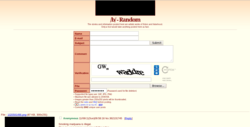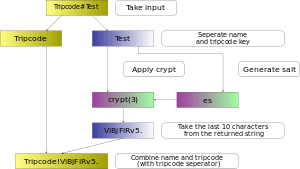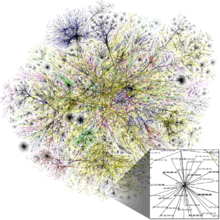Imageboard

An imageboard or image board is a type of Internet forum which operates mostly via posting images. The first imageboards were created in Japan, and many English language imageboards today are centered on Japanese culture. They are based on the textboard concept.
Characteristics
Imageboards, similar to bulletin board systems, are used for discussions of a variety of topics. The primary focus of imageboards, however, is directed away from text posts, and is instead placed on picture posts. The two share many of the same structures, including separate forums for separate topics, as well as similar audiences. Imageboards are much more transitory with content—on some boards (especially highly trafficked ones), the thread deletion time can be as little as 10 minutes. The most popular English language imageboard, 4chan, tends to revolve around Japanese culture such as CG artwork or anime. In Japan, where imageboards are more common, topics vary widely, ranging from trains to current news.
Imageboards are also different from online galleries in that most of the works posted are not made by the poster, but instead are taken from other online sources: galleries, other imageboards, and edited pictures.
Tripcodes

Most imageboards and 2channel-style discussion boards allow (and encourage) anonymous posting and use a system of tripcodes instead of registration. A tripcode is the hashed result of a password that allows one's identity to be recognized without storing any data about users. Entering a particular password will let one "sign" one's posts with the tripcode generated from that password, while trying to take another user's tripcode and compute their password from it (for instance, to make posts that appear to come from a particular person) is computationally difficult. For those who want a custom tripcode, however, there are custom tripcode generators available, such as Meriken's Tripcode Engine[1] and MTY_CL.[2] In general, anonymity is considered to be one of the advantages of an imageboard, and some boards have from time to time removed the ability to post with a name altogether (known as "forced anonymous/anonymity").
Software
There are two primary types of imageboard software packages in widespread use: linearly directed imageboards modeled closely after Futaba Channel (in which content is posted through hierarchical subsections of topical interest, usually denoted by a forward slash such as "/f" for female), and nonlinear imageboards modeled after Danbooru (usually indicated by the usage of controlled folksonomic vocabulary for topical tagging and search).
Futaba Channel clones
There are currently several Futaba-based imageboard software packages in widespread use: Futallaby, Wakaba, Kusaba X.
Futallaby is a PHP script based on the Futaba script from Futaba Channel. Although the Futallaby source is still freely available at 1chan,[3] it is no longer in development, and the download page recommends using Wakaba instead, stating that "Wakaba can do everything Futallaby does and so much more." Futallaby started as a translation of Futaba, later retooled to support XHTML and customizable CSS styles. It is mostly notable for being the first open source English imageboard script.
Wakaba is a Perl imageboard script with a SQL backend to store thread information.[4] It is designed to be more efficient and cleanly written than other scripts that are available, while preserving the same kind of functionality. Wakaba is one of the most popular western imageboard software scripts, used most notably by iichan (Wakachan).[5] Because of its focus on bare-bones functionality, Wakaba lacks many of the modern amenities provided by 4chan's Yotsuba,[6] and newer imageboard scripts. A few users have attempted to remedy this by forking the original project and adding in features they consider beneficial. Two FOSS examples of this are frankusr's Wakaba fork,[7] and the user experience focused Glaukaba.[8]
Kusaba was a modular imageboard software written in PHP, which used MySQL.[9] The creator has discontinued the project, however, and recommends TinyIB instead.
Kusaba X is a continuation of Kusaba. Like Kusaba, Kusaba X is written in PHP, and is designed with modularity in mind. It requires a MySQL or SQLite database to run. Kusaba and its derivatives were at one time some of the most popular imageboard solutions. Kusaba X is still in development and the developers state that version 1.0.0 is to be released soon.
Danbooru-style boards
Usually referred to as a "booru" (plural "boorus"). Unlike Futaba-inspired imageboard software packages, Danbooru and derivatives aim for a non-hierarchical semantic structure in which users are able to post content and add tags, annotations, translations, and comments.
There exist a number of different Danbooru-style imageboards, both those with shared source code and those that are not released for others to use. The two main Danbooru derivatives are Gelbooru and MyImouto.
| Shared | Software | Programmed in | License | Notes |
|---|---|---|---|---|
| Yes | Danbooru | Ruby on Rails | FreeBSD | Uses PostgreSQL.[10] |
| Yes | CamelBoard | PHP | FreeBSD | Does not use or require MySQL. |
| Yes | Shimmie | PHP | GPLv2 | |
| Yes | naranai 1.3.x | PHP | GPLv3 | Built to replace Danbooru because author considered Ruby unsuitable.[11] |
| Yes | szurubooru | Python | GPLv3 | |
| Yes | Moebooru | Ruby on Rails | MIT | |
| Yes | MyImouto | PHP and MySQL | MIT | PHP port of Moebooru. Uses a custom Ruby-on-Rails-like framework.[12] |
| Yes | Sequenzia | PHP and MySQL | MIT | Modified and re-designed port of MyImouto for the Sequenzia Project.[13] Some code is specialised for the Sequenzia Project and AC Research.[14] |
| No | Gelbooru 0.2.x | PHP | Proprietary | Gelbooru 0.1.x is open source but 0.2.x currently is not. |
| No | Octabooru | PHP | Proprietary | (temporarily down due to host server issues) |
| No | Metabooru | Python | Proprietary | |
| No | booru-on-rails | Ruby on Rails | Proprietary | "The 'booru-on-rails' project that powers Derpibooru is planned to be released to the public once the debugging is complete." |
Imageboards
Futaba Channel
Futaba Channel (ふたば☆ちゃんねる), or "Futaba" for short, is a popular, anonymous BBS and imageboard system based in Japan. Its boards usually do not distinguish between not safe for work and clean content, but there is a strict barrier between two-dimensional (drawn) and three-dimensional (computer graphics (CG) and photographic) pictures that is heavily enforced and debated.[15]
4chan
4chan is an English language imageboard based on the Japanese imageboard Futaba Channel. This imageboard is based primarily upon the posting of pictures (generally related to anime, manga, and popular culture) and their discussion. The Guardian describes it as "at once brilliant, ridiculous and alarming."[16]
The site and its userbase have received attention from the media for a number of reasons, including attacks against Hal Turner on his Internet shows,[17] distributed denial-of-service attacks against eBaum's World,[18][19] taking part in Project Chanology,[20] and multiple cases of anti-animal abuse reports.[21]
Many Internet memes have originated there, including lolcats,[22][23][24] rickrolling and Pedobear.
8chan
8chan (or Infinitechan) is a primarily English language imageboard, though there are boards dedicated to other languages. Just like 4chan, 8chan is based on posting pictures and discussion anonymously, but unlike 4chan's anime focus, 8chan lets its users decide what they want to discuss by allowing any user to create their own board dedicated to any topic, a concept first made popular by news bulletin boards like Reddit. 8chan also claims to have a strong dedication to freedom of speech and allows all content—so long as the discussion and board creation abides by United States law.[25] However, local moderators enforce the rules of their own boards and may delete posts as they see fit. It is currently partnered with the Japanese textboard 2channel.
420chan
An English-language imageboard based on cannabis culture[26] which was created on April 4, 2005 by Kirtaner Aster. The name is a reference to the larger 4chan[27] and the code term 420 of the cannabis subculture. Its boards include various drug-specific boards,[26] as well as a board featuring a chatterbot.[28]
Hispachan
Hispachan was launched in November 2012[29] as a global imageboard for all Spanish-speaking countries. Vice Magazine describes it as "a site for completely anonymous Spanish-language discussion that has proven popular among hackers since its launch in 2012".[30]
Krautchan
A primarily German-language imageboard that was founded in 2007.[31] The name is an allusion to the ethnophaulism Kraut for Germans. In 2009, after the Winnenden school shooting, the Interior Minister of Baden-Württemberg cited a post on the imageboard in a press conference that appeared to forewarn of the shooting, but was later found to be fake.[32][33][34] The site also features a popular English language board, /int/, which is also the origin of the Polandball internet phenomenon.
Ylilauta
Ylilauta is a Finnish-language imageboard that was founded in 2011 with the joining of the two most popular Finnish imageboards, Kotilauta and Lauta.net.
Wizardchan
Wizardchan is an imageboard which discusses topics including anime, hobbies, and depression. Users often discuss suicide or self-harm, and a controversy emerged in the board's community about whether to refer users to suicide prevention hotlines.[35]
See also
References
- ↑ Meriken's Tripcode Engine
- ↑ MTY_CL
- ↑ "Futallaby Imageboard Script". 1chan.net. Retrieved 2011-09-29.
- ↑ "wakaba.c3.cx". wakaba.c3.cx. Retrieved 2011-09-29.
- ↑ "wakachan.org". wakachan.org. Retrieved 2011-09-29.
- ↑ "4chan Inline Extension News Post".
- ↑ "frankusr's Wakaba Fork Repository".
- ↑ "Glaukaba Imageboard Script".
- ↑ tslocum. "Kusaba Imageboard Script". GitHub. Retrieved 2013-06-06.
- ↑ From Readme of the source code.
- ↑ From Readme of the source code.
- ↑ From Readme of the source code.
- ↑ From Sequenzia Project Wiki page.
- ↑ From Readme of the source.
- ↑ 2chan.net Futaba Channel
- ↑ Sean Michaels (2008-03-19). "Taking the Rick | News | guardian.co.uk Music". London: Music.guardian.co.uk. Retrieved 2011-09-29.
- ↑ "Cyber foes find ways to silence hate-talk radio host". freep.com. Archived from the original on September 29, 2007. Retrieved 2007-02-28.
- ↑ "Lindsay Lohan causes massive DoS war". Vitalsecurity.org. 2006-01-09. Retrieved 2008-01-20.
- ↑ Bertiaux, Michaël (2006-01-09). "Ebaumsworld assiégé" (in French). Le Lézard. Retrieved 2008-01-19.
- ↑ George-Cosh, David (January 25, 2008). "Online group declares war on Scientology". National Post. Canwest Publishing Inc. Retrieved 2008-01-25.
- ↑ Popkin, Helen A.S. (August 31, 2010). "Web video: Woman throws puppies in river, 4chan tracks her down". MSNBC Technology. MSNBC.com. Retrieved 2010-08-31.
- ↑ "Lolcats' demented captions create a new Web language", Tamara Ikenberg, The News Journal, 9 July 2007
- ↑ Richards, Paul (2007-11-14). "Iz not cats everywhere? Online trend spreads across campus". The Daily Pennsylvanian. Retrieved 2008-01-19.
- ↑ Steel, Sharon (2008-02-01). "The cuteness surge". The Phoenix. Retrieved 2008-02-10.
- ↑ Howell O'Neill, Patrick (November 17, 2014). "8chan, the central hive of Gamergate, is also an active pedophile network". The Daily Dot.
- 1 2 Olson, Parmy. We Are Anonymous. Retrieved 28 March 2015.
- ↑ How imageboard culture shaped Gamergate
- ↑ "Taimapedia - 420chan". Retrieved 28 March 2015.
- ↑ Hispachan's History
- ↑ "This Murder Has Exposed the Dark Side of Mexico’s Hacking Community" Vice News.
- ↑ Reißmann, Ole; Stöcker, Christian. We are Anonymous: Die Maske des Protests - Wer sie sind, was sie antreibt ... p. 22. Retrieved 28 March 2015.
- ↑ "Massacre in Winnenden: School Shooting Internet Post a Fake". Spiegel Online. March 13, 2009.
- ↑ Roth, Daniel. Zündstoff für den "Columbine-Effekt"? Die Berichterstattung über School Shootings in deutschen Print- und Online-Medien. p. 116. Retrieved 28 March 2015.
- ↑ "German police now question whether killer posted warning". CNN. March 12, 2009.
- ↑ Hess, Amanda. "Please Do Not Downvote Anyone Who's Asked for Help". Slate.
External links
- Overscript - a list of imageboard software
- AllChans - OverChan V.3 - a list of imageboards

